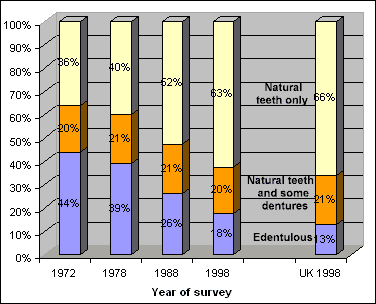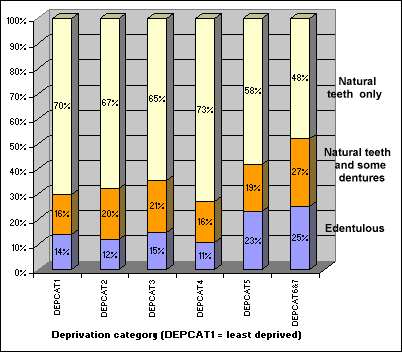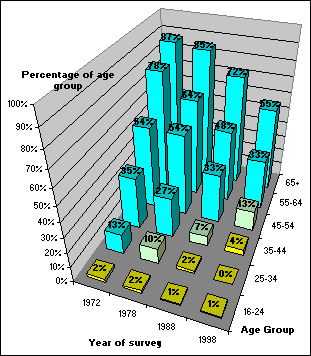Ths peer reviewed article was first published in the journal Tuith OnlineOral status of adults in Scotland 1972-1998(based on the 1998 Adult Dental Health Survey) by Nigel M. Nuttall, Dental Health Services Research Unit This article is part 1 of 4 of an invited article series. View parts 2 to 4. This article looks at what this series of surveys reveals about tooth loss and denture wearing among the population of Scotland. Surveys of adult oral health have been carried out in Scotland since 1972. The latest of the decennial surveys was undertaken in 1998 by the Office of National Statistics in collaboration with the dental schools of the Universities of Birmingham, Dundee, Newcastle and Wales (Kelly et al., 2000). These surveys have tended to show that Scotland has poorer dental health than the average for the United Kingdom. In 1988, when the previous dental health survey was carried out, Scotland was effectively 10 years behind England both in terms of the proportion of the proportion of its population who had some teeth and the average number of missing teeth in dentate adults. This article looks what the 1998 survey reveals about trends in tooth loss and denture wearing in Scotland by comparing the findings with that of the previous surveys that have been undertaken on an approximately decennial basis since 1972. Total tooth loss and denture wearing in Scotland 1972-1998 The clearest indicator of the general improvement in the status of the mouths of the Scottish population over the last 26 years is the finding that whereas in 1972 64% of the population were reliant on dentures to some extent by 1998 almost the same proportion was wholly reliant on their own teeth (figure 1). Since the first survey in 1972 the proportion of the population with no natural teeth has fallen by more than a half from 44% to 18% in 1998. However, although this is an improvement, the present level is significantly higher than the level that has been found at the same time in England (12%) and for the UK as a whole (13%). Furthermore, a less encouraging finding is that the proportion of people who require some dentures in addition to their natural teeth has remained unchanged at around 20% for the last 26 years. Figure 1. Oral status of adults in Scotland 1972-98 Deprivation and total tooth loss 
The impact of deprivation on health is increasingly becoming appreciated and dental surveys of children have shown that deprivation is associated with dental health (Pitts et al., 1999). A system for measuring level of deprivation used in Scotland at the present time are DEPCAT scores (Carstairs and Morris, 1991) which can be easily assigned on the basis of a person's postcode. The scores are determined for each area from national census data using the level of overcrowding in households; male unemployment; the proportion of social classes IV or V and the proportion of people in private households with no car. DEPCAT analyses have previously shown deprivation to be associated with a variety of clinical measures of health such as the incidence of cerebrovascular disease, coronary heart disease and mental health problems (McLaren and Bain, 1998). This system is currently used in dentistry for determining who is eligible for the enhanced capitation registration payments scheme. Figure 2 shows that people who live in the areas of high deprivation were much less likely to be wholly reliant on their own natural teeth than the most affluent people. Over half of the least affluent (DEPCAT 6&7) required some dentures (52%) in comparison less than a third of those who lived in a DEPCAT1 area (30%). A quarter of those who were lived in the poorest areas had lost all of their teeth by 1998 compared with 15% or less in the better-off areas. Figure 2. Adult oral status in Scotland in 1998 by deprivation category (DEPCAT score) 
Social class of the head of household is also a type of deprivation measure and this has been assessed at all surveys since 1972 (figure 3). From 1972 through to 1998 total tooth loss has been markedly lower among those from a non-manual working background than those from an unskilled manual working background. However, there has been a steady decline in the proportion of people who have none of their own teeth among people from each social class background. Nevertheless, those from an unskilled manual background in 1998 were still only at the level of those from a skilled manual background 10 years previously and only marginally ahead of non-manual workers 20 years previously. Figure 3. Total tooth loss by social class of head of households in Scotland 1972-1998 
Rate of Tooth LossThe trends looked at so far have been patterns of results through the surveys, but once someone has lost all their teeth, they stay that way. So even if no more teeth are lost in the population from now on, there would still be a proportion of the population who would continue to be found to have no teeth. A way of looking at the results of successive surveys to get a feel for the rate at which tooth loss is occurring is to follow the progress of a cohort of people as they get older, for example people aged 25-34 in 1978 would be 35-44 in 1988 then 44-54 in 1998. In figure 4 this has to be done by starting from 1978 (as the previous survey was only 6 years before in 1972). The rate of tooth loss since 1978 looked at in this way is quite low; only 2% of 16-24 year olds had lost all of their teeth by 1978 which remained unchanged within the same group who were aged 25-34 in 1988 and rose to 4% by the time they were aged 35-44 in 1998. Among the next age group those aged 25-34 in 1978 there was actually a drop in total tooth loss from 10% in 1978 to 7% in 1988 in the cohort; this is an impossible event arising from variations between samples and is not actually statistically significant. By 1998 the level of total tooth loss in this group had risen to 13%. An aspect that is highlighted in figure 4 is the level of tooth loss among groups who have spent all their life within the NHS era (highlighted in yellow) and those containing people who had all lived some time before the introduction of the NHS (highlighted in blue). The contrasts between the groups are not only the overall level of experience of tooth loss but also the subsequent rate at which edentulousness is occurring. Figure 4. Total tooth loss by age group in Scotland 1972-1998 
The oral health target for ScotlandThe oral health target concerned with adult dental health set by the Scottish Executive Department of Health for Scotland is concerned with tooth loss. It intends that by 2010 more than 95% of 45 to 54 year olds should have some natural teeth. Figure 4 shows that among those aged 35 to 44 (who will be 45 to 54 in 2008) 4% have already lost all of their natural teeth. This means that no more than 1% of the cohort can become edentulous over the next 10 years if the target is to be met. Although total tooth loss is obviously much less common now than in the past it may be quite difficult to achieve this target. Thanks and DisclaimersThe DHSRU would like to thank all the dentists and interviewers who often worked unsocial hours to undertake the dental examinations and people who gave their time to be interviewed and dentally examined. This work was undertaken by a consortium comprising the Office for National Statistics and the Dental Schools of the Universities of Birmingham, Dundee, Newcastle and Wales who received funding from the United Kingdom Health Departments; the views expressed in this publication are those of the author and not necessarily those of the Health Departments nor of the other members of the consortium. Nigel Nuttall acknowledges support from the Chief Scientist Office of the Scottish Executive who do not necessarily share the views expressed. ReferencesKelly, M., Steele, J., Nuttall, N., Bradnock, G., Morris, J., Nunn, J., Pine, C., Pitts, N., Treasure, E., and White, D. (2000) Adult Dental Health Survey - Oral Health in the United Kingdom 1998. London: The Stationery Office. Pitts, N.B., Nugent, Z.J., and Smith, P.A. (1999) Report of the 1998/9 Scottish Health Boards' Dental Epidemiological Programme survey of 14-year-olds Dundee: University of Dundee. Carstairs, V. and Morris, R. (1991) Deprivation and health in Scotland. Aberdeen: Aberdeen University Press. McLaren, G. and Bain, M. (1998) Deprivation and Health in Scotland. Insights from NHS data. Information & Statistics Division, Edinburgh. |
|
Web space provided by the University of Dundee,
maintained by
the Dental Health Services Research Unit. Valid XHTML1.0
|
 |
Evidence-based dentistry web-site | |